Baseball begins fall practice
By David Cuevas Sports ContributorThe road to Omaha has officially begun for the Texas State baseball team as it opened fall practices for the 2023 season in September.
The Bobcats are coming off the greatest season in program history, in which they achieved the most wins in a single season by Texas State baseball with a 47-14 record.
For head coach Steven Trout, it feels good to return to the diamond with his squad after a long summer.
“It’s awesome to get them back and get back into team practice where they start competing for jobs and start competing to find a way to get wins," Trout said. "It’s great to be out here at the yard and have my guys back and to get after it with them.”
Trout, the 2021 Ron Maestri Sun Belt Coach of the Year, has been utilizing fall practice for the team to improve in the areas he felt hurt them in 2022, starting with defense.
“Just from a fielding percentage number I think we were somewhere in the middle to the bottom three-quarters of the Sun Belt," Trout said. "That’s one thing we really emphasized on this fall.”
Texas State’s historic 2022 season ended with a heartbreaking 4-3 loss to Stanford in the NCAA Regional Finals. For junior pitcher Tony Robie, the feelings he had after that loss are something he will never forget, and he believes the experience will serve as motivation for the club heading into the season.
“I think a lot of it brings an edge to a certain extent because we’ve done it before," Robie said. "We’ve sustained success to a pretty extreme extent, so there’s no more of a question."
For Trout, carrying the momentum the team established in 2022 into the 2023 season will be vital if the Bobcats want to make a second consecutive deep postseason run.
Trout said that the extended period of success last season built confidence within his squad, and he thinks his returning players will continue to sustain that success.
“You got to wake up very hungry and find a way to get better every single day," Trout said. "So far to this point, I feel like this group has done this.”
and Arts: Campus Gallery

Meet Pawfficer Brady: TXST's first therapy K9
By Haley Velasco Assistant Life and Arts Editor
From getting used to a new environment away from home, taking exams or tackling difficult courses, college life can be difficult. To ease stress, the Texas State University Police Department (UPD) has welcomed Pawfficer Brady, Texas State’s first therapy K9, to be a furry companion for students.
The plan to start a therapy K9 program was led by Matthew Carmichael, the director and chief of police at UPD. Prior to joining Texas State UPD, Carmichael served on city and university levels in the roles of a police sergeant, lieutenant and chief of police.

Through all of his experience, Carmichael never had any experience with a canine therapy program, but he was ready to tackle it head-on as he knew Texas State students could use a resource like Brady. Since his arrival on campus in June, Brady and his handler, Kendra Marsteller, have already made an impact.
"Brady has changed us as an organization, as corny as it sounds," Carmichael said. "It’s hard to have a bad day with Brady. I think a lot of the work that Kendra does, too, is just phenomenal, because she’s working with members on
REMEMBRANCE
campus whether it’s students, faculty or staff who have been in crisis that are now being taken care of."
After he was surrendered when he was a couple of months old in Brevard County, Florida, Brady was enrolled in the Paws & Stripes College at the Brevard County Sheriff’s Office to learn obedience training by selected and trained jail inmates.
After completing training, Brady was selected to participate in the advanced eight-week training course to serve as a Law Enforcement and Multidiscipline Crimes Against Persons Therapy Dog. UPD filled out an application for a therapy K9 and the Paws and Stripes College matched them with Brady.
Marsteller, UPD's mental health officer and Brady’s handler, traveled to Florida to bring Brady to Texas. While in Florida, she caught a glimpse of his capabilities in a shopping mall.
"I saw in Florida, he walked up to two girls at the mall we were visiting," Marsteller said. "I had no inclination that they were having a bad day until I started talking to them, but he already knew and went straight to them."
Veteran honors fallen brother-in-law during 500-mile running journey
By Nichaela Shaheen News EditorTexas State exercise and sports science graduate student and recently retired Marine veteran Tim Barrientez honored his fallen brother-in-law who was killed in action by running 500 miles in one month. The campaign's goal is to create traction for a scholarship he and his wife founded in his brother-in-law’s name.
U.S. Army Private first class (PFC) Rey David Cuervo was killed in action on Dec. 28, 2003, while serving in Iraq. He left behind family members who have made their mission to keep his name alive.
Tim, Cuervo's brother-in-law, began a journey of running 500 miles in one month at the beginning of September. The campaign's goal is to match every mile ran to dollars for a scholarship that will be awarded to Port Isabel High School students in their hometown of Port Isabel, Texas.
“I had some ideas and I spoke to my wife [who] is his sister, I was like, ‘you know, I'd like to create a scholarship in his
name and raise money to then turn around and give back to our hometown for the high school,' and that was the idea,” Tim said.
Even though Port Isabel named a street in honor of Cuervo, the scholarship was another way to keep his legacy alive, and Tim's vision became all about the execution.
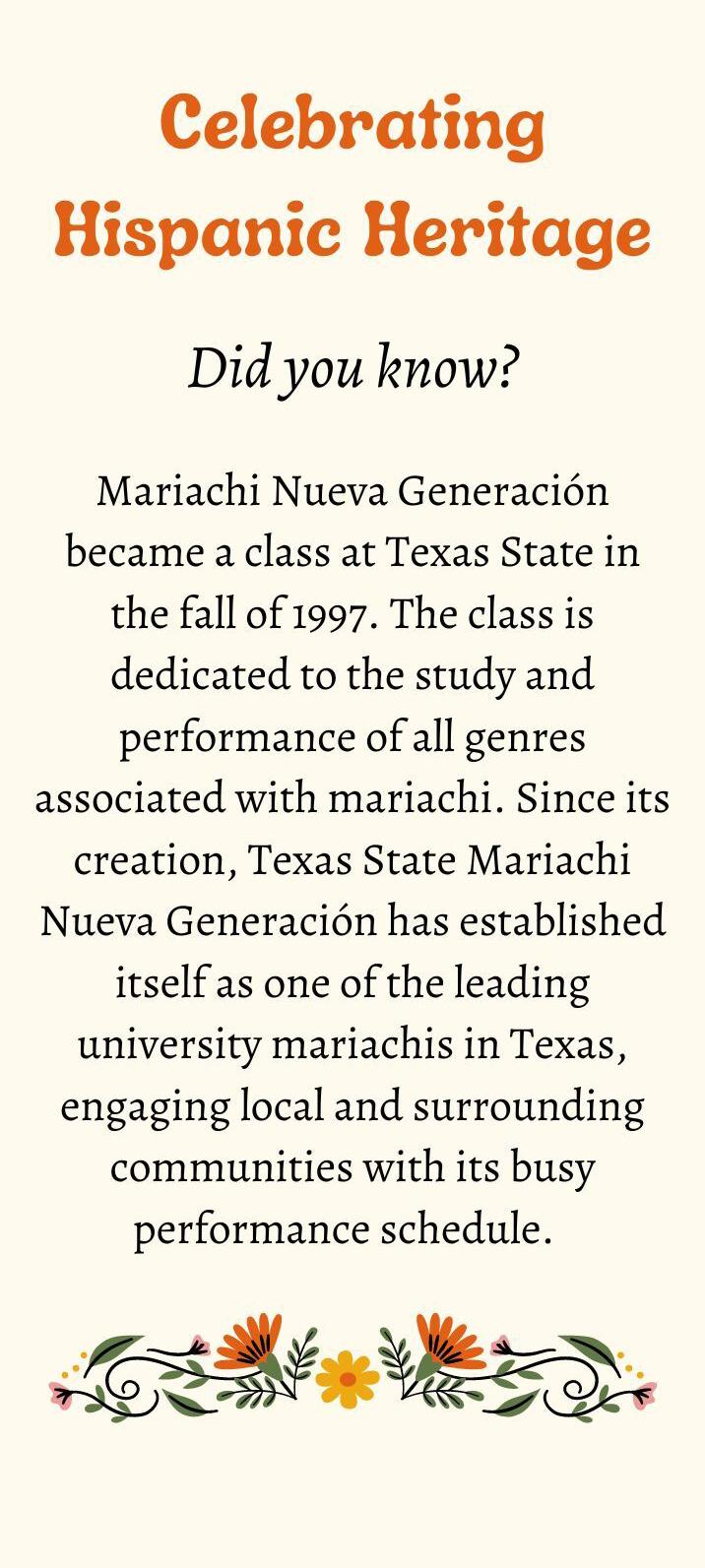
The Rey David Cuervo Memorial Fund scholarship will be awarded to two Port Isabel High School students who show leadership qualities, community involvement and a fitness factor. Applicants will write a ‘thank you' essay to U.S. Army PFC Rey David Cuervo for his service and discuss what winning the scholarship would mean to them. Tim and his wife Valentina Cuervo Barrientez, Cuervo's sister, will be the ones to read the applications and ultimately decide who will receive the awards.
His main concern was about bringing awareness to the scholarship in hopes of sparking interest for donations. The 500 mile journey is the idea he landed on.
Pawficcer Brady lays out on the steps outside Old Main, Friday, June 24, 2022, at Texas State. PHOTO COURTESY OF STEPHANIE SCHULZTrinity Building 203 Pleasant St. San Marcos, TX 78666 (512) 245 - 3487
Editorial Staff
Editor-in-Chief: Arthur Fairchild stareditor@txstate.edu
Managing Editor: Sarah Hernandez starmanagingeditor@txstate.edu
Design Editor: Kadence Cobb stardesign@txstate.edu
News Editor: Nichaela Shaheen starnews@txstate.edu
Life & Arts Editor: Marisa Nunez starlifeandarts@txstate.edu
Opinions Editor: Dillon Strine staropinion@txstate.edu
Sports Editor: Carson Weaver starsports@txstate.edu
Multimedia Editor: Vanessa Buentello starmultimedia@txstate.edu
Engagement Editor: Meadow Chase starengagement@txstate.edu
Digital Products Developer: Monica Vargas starasstweb@txstate.edu

Creative Services Director: Michele Dupont starcreative@txstate.edu
Public & Internal Relations
PIR Director: Elle Gangi starpr@txstate.edu
Full-Time Staff
Director: Laura Krantz laurakrantz@txstate.edu
Student Publications Coordinator: Caitlin Mitchell cf1188@txstate.edu
About Us
History:
The University Star is the student newspaper of Texas State University and is published every Tuesday of the spring and fall and once a month in the summer semesters. It is distributed on campus and throughout San Marcos at 8 a.m. on publication days with a distribution of 3,000. Printing and distribution is by the New Braunfels HeraldZeitung.

Copyright: Copyright Tuesday, October 4, 2022. All copy, photographs and graphics appearing in The University Star are the exclusive property of The University Star and may not be reproduced without the expressed written consent of the editor-in-chief.
Deadlines: Letters to the Editor or any contributed articles are due on Monday the week prior to publication.
Corrections: Any errors that are in the pages of The University Star and brought to our attention will be corrected as soon as possible.
Visit The Star at universitystar.com
FROM FRONT REMEMBRANCE
“David was a runner and he was a standout runner. His life was cut short and I'm an avid runner and fitness guy and I was like, ‘okay, so how can I tie in fitness into this’ I need to raise money,” Tim said. “Well, you have to do something crazy, especially in the fitness world. You have to do something above and beyond and I chose to run 500 miles because in the running community that's a crazy number.”
Throughout the month of September, Tim set out to complete the daunting mileage. In order to complete the mileage in one month, he needed to average 16.6 miles a day, but he had to approach it logistically.
“That's a lot [of miles] every day, every day, every day, every day. So how do you make it easier on yourself to get to the end? Well, you have to front-load,” Tim said. “You have to run some extra miles for the first two to three weeks to then relieve yourself or get a break in the last few days.”
Running 18-19 miles every day for the first few weeks into the month to balancing graduate school classes, to spending time with his two kids and wife at home, Tim had to stick to a strict schedule.
He said he had to remember the greater purpose behind his struggle.
"I constantly think of the sacrifice of my brother-in-law, not just him but, everyone that that paid the ultimate sacrifice and didn't come back," Tim said. "The service members and just being from that generation and seeing other veterans do some crazy stuff to bring awareness."
Tim said that it will all have been worth it once he and his wife get to hand the awards out to the recipients during senior awards night.
Valentina feels the scholarship is the perfect way to not only give back to the community but also allow her brother to live on.
“With the scholarship, we get to give back to our community. Especially as families of loved ones who have passed, and especially when they pass at a young age, you always wonder what could have been. David was only 24,” Valentina said. “He had just re-enlisted and he was talking about looking for a life partner. So you wonder who he would have become, and with the scholarship, it's kind of like those that we're giving it to get to, [we] kind of give them a little piece of life for David. He gets to go on that journey of what they become.”
The last time Valentina spoke to her brother was on Christmas. Although her brother has passed, she said running makes her feel most connected to him.
“David had raw talent, his coaches from school will tell you. In eighth grade, they ran him up against the varsity team and he came in the top three. He just naturally had that raw talent,” Valentina said. “So that's kind of how running has been a big part, when David was killed, I stopped running for like seven years because there was that connection that I had with him.”
ACTIVISM
She said that her memory of him as the typical protective older brother will always stick with her.
“He was very protective of our mom. If you pointed it out that he was protective, he'd be like, ‘I don't know what you're talking about, he always did that,” Valentina said. “He didn't like to draw attention to himself, that's kind of the person he was. He was a quiet person, but for those he cared for, he protected them fiercely.”
Six in ten Americans have immediate family ties to those who have served in the military. Valentina believes it is important to share the stories of loved ones lost in battle.
Tim ended his journey accompanied by friends and family including his own son on Sept. 30 while carrying a flag with his brother-in-law's name hanging off the side. His son, Julien David Barrientez, felt that it was more than just the final six miles.
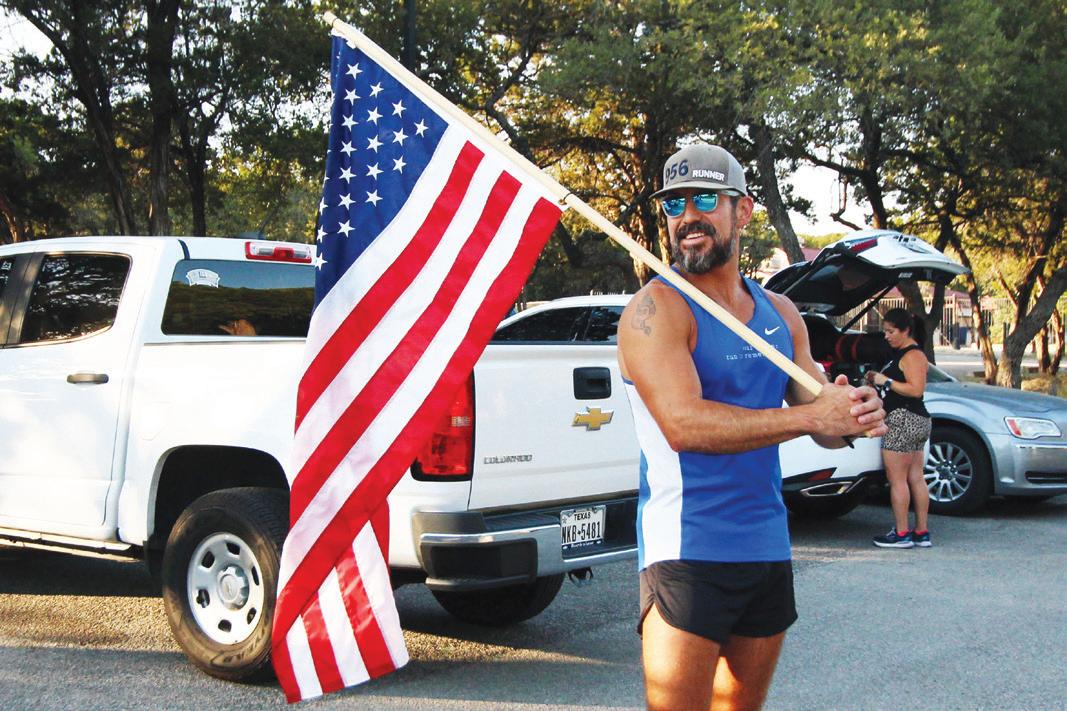
“For me, it was very personal, my dad is my hero figure. I've always been chasing after my dad growing up, I just want to be half the man he is, so it's very personal.” Julien said.
Videographer Santino Corrales has been by Tim’s side throughout the campaign documenting the long journey. Seeing his grit has only inspired him to do more.
“Witnessing that firsthand, I've never met somebody so determined. I will take some of the way he lives his life and put it into mind. He's awakened something in me too,” Corrales said. “I'm grateful for him taking me on this journey and we're so grateful to put this video out and show everybody the behind-the-scenes work.”
Now that Tim has completed the mileage, the next part of the journey is raising more awareness to increase the scholarship fund.
Donations to the scholarship fund can be made at https://linktr. ee/davidcuervoscholarship. To see behind the scene clips of Tim Barrientez's journey, visit his Instagram @eltimo956.
Fight for justice continues after SMPD officer kills woman
By Katie Smith Assistant News EditorOn June 10, 2020, Pamela Watts' life was altered forever when off-duty San Marcos Police Department (SMPD) Officer Sgt. Hartman struck her car, severely injuring her and killing her partner Jennifer Miller. Two years later, activists are still fighting for justice and reform surrounding the fatal case.
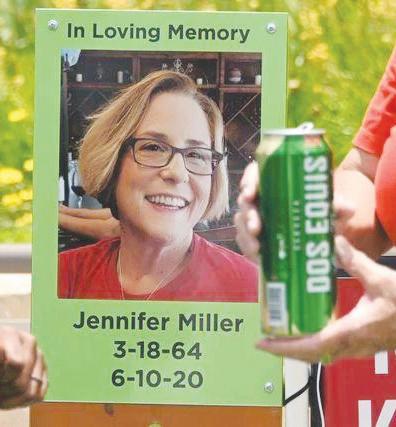
With a mountain of evidence piled up against Hartman, there is still no indication that district attorney Bryan Goertz opened the evidence file. To Watts' disbelief, a grand jury voted and Hartman was only charged with a class C traffic ticket for running a stop sign.
Body camera footage from the day of the incident shows that Sgt. Ryan Hartman verbally refused to give a sample in order to test his blood alcohol content, stating that he "caused the death of somebody by not paying attention."
Investigators revealed that Hartman was driving greater than 50% of the legal speed limit with an open 24-ounce can of Dos Equis beer in his vehicle whilst talking on the phone. His refusal to prove sobriety at the scene was just the start of the lack of accountability that Watts has seen time and time again from SMPD.
"I don't see an end to this because I haven't seen any action from the city of San Marcos or the SMPD to change their ways," Watts said. "If my activism does anything, I hope it shows other people how they can fight and that activists like Mano Amiga will shine a floodlight on people's actions."
Formerly reluctant to use the word activist to describe herself because of the negative connotation it held in her mind, Watts has now found that it takes an army to bring about necessary change.
Jordan Buckley, the founder of the nonprofit organization Mano Amiga, found Watts one day advocating justice for Miller.
"I didn't know what his agenda was, I just knew it was personal for me," Watts said. "I didn't yet realize I couldn't move a mountain by myself and that this is going to take your generation, mine and everybody to care enough about each other, listen and do more."
Utilizing access to open records and organizing events to draw attention to this tragedy were Buckley's ways of creating a solid support system and raising awareness of the situation in the community.
"Pam was still in the neurologist's office when Chief Standridge called to tell her that he was putting Hartman back to work," Buckley said. "We also discovered that Mayor Jane Hughson knew about it and didn't decide to tell anyone, so basically the cops just tried to sweep it under the rug I think in hopes that no one would ever find out about it."
According to Buckley, it was "only through the courage of Pam standing on the side of the road" that the community and media ever found out about what happened.
Since Mano Amiga's involvement in the case, the organization has sat through every meet and confer meeting to implement reforms within the police department called "The Hartman Reforms." Samantha Benavides, communications director for Mano Amiga, has been working alongside Watts to
push for these reforms to be passed. The 180-Day Rule, which gives the chief 180 days to file a complaint, was extended and is only one of the five reforms to be passed so far.
"All these reforms that we were demanding they take the initiative to implement are very reasonable," Benavides said. "They shouldn't have the chance to try and run out the 180 days before so officers don't have to be disciplined."
Attempting to stay involved and to "stand up for the little guy" as Watts puts it, is Mano Amigo's mission. Elle Cross, the right to justice coordinator for Mano Amiga, is pushing to repeal the ratified contract regarding The Hartman Reforms. She stresses the importance of voters and collecting signatures for any real change to occur.
"Our goal is to gather 800 signatures within five weeks from now," Cross said. "Time passes quickly but we're sending people out at least five days a week to knock on our community members' doors and collect signatures."
Booths will be set up at the Frights and Sounds festival on the weekend of Oct. 8, as well as at the Lost River Film Festival on the weekend of Oct. 20. Mano Amiga and Watts hope to get at least 400 registered voters on campus alone in order to nullify the ratified agreement. According to Watts, Benavides and Cross, student involvement through signatures is the next step towards getting reform to happen.
"It's an injustice system," Watts said. "I came to know that but I hadn't been treated like this all my life so I had no clue, but thank goodness for Mano Amigo because there need to be people holding people accountable and that's not happening."
Pamela Watts holds a 24oz can of Dos Equis beer in front of a memorial sign for Jennifer Miller while talking to KXAN reporter Jala Washington, Thursday, June 10, 2021, at San Marcos City Hall. An identical can was found on the night of the collision in the car of Sgt. Ryan Hartman, who refused a blood alcohol draw at the scene. STAR FILE PHOTO Tim Barrientez completes his 500-mile run to honor his late brother-in-law, Friday, Sept. 30, 2022, at Eisenhower Park. PHOTO BY NICHAELA SHAHEEN& ARTS
PERFORMING ARTS
Department of Theatre and Dance modernizes Greek tragedy
By Ben Middleton Life and Arts ContributorThe house lights dim inside Patti Strickel Harrison Theatre as the dark ethereal music fades into the start of the Texas State Department of Theatre and Dance's production of "Antigone." For the next hour and 15 minutes, the audience will experience a production that consists of a claustrophobic and bleak retelling of the classic Greek tragedy.
The Department of Theatre and Dance presented its production of Bertolt Brecht's "Antigone" from Sep. 7 to Oct. 2. Director Jess Hawthorne Fiene, a graduate student and third-year directing candidate, used an experimental approach to directing to give the play a more modern feel and effectively immerse the audience into the themes and conflict of the story.
"[The script is] like this heightened language, but what we've tried to do is make it feel like we're just in 2022, and make sure that the things that the actors are saying feel just as relevant and just as human and resonate with whoever is sitting right out here as much as possible," Fiene said.
Brecht's version of "Antigone" is a retelling of the Greek tragedy originally written by Sophocles. The Brecht version was written shortly after World War II and the play shows the fall of the City of Thebes due to mistakes made by the king of the city, Creon. Brecht based Creon's character on Hitler’s rule of Germany, portraying him as a cruel and tyrannical leader. Antigone is a young woman who stands up against the rule of Creon.
"A huge thing of why I wanted to do this play, even though it is so dark, is that we have to examine human failure and we have to be okay with human failure in order to accept it and learn from it," Fiene said. "Because at the end of the day, these characters, they don't realize what they've done until it's too late."
To add energy to the show, Fiene recruited drummer David Collis to make a live soundscape for the show. The drums were an early addition to the production. Fiene and Collis started planning the drums last semester and shared playlists to find inspiration.
During the show, Collis performed on stage where the actors periodically interacted with him and his drum set. Collis drew inspiration from experimental bands like This Heat and Sounds of Burma to work with Fiene to craft the soundscape of the show.
Using his laptop, Collis altered the sounds of his drum set to give dark and at times unsettling texture beneath the actors. Only a couple of standard drum beats were played throughout the show as Collis prefers to use loops of sound and reverberate the actors' voices back to them.
"Environmentally, there's a lot of aspects involving the actors where they're kind of losing their minds and [in] this drift in reality," Collis said. "So it's not so much trying to make the nightmare hellscape but more so to feed off the distortion of reality, as what I am creating sonically is a distortion of an acoustic drum set."
In a party scene, Creon repeatedly hits a piñata and Collis synchronized the hits of his drums with that of Creon’s baseball bat, selling the illusion that Creon was making the noise.
"When I found out I got the roll. I was like, 'okay, I'm doing this really dramatic, classical text,' and then we have drums in it. We have a party on stage, we have like, all of these things that are just allowing us to have a little bit more fun." Kaleb Quinn, a theatre junior who played Creon, said. "It kind of makes it a little bit more visceral. And in your body, it feels very punk rock and almost like throwing a concert every night. And it really gives it that kind of political, rebellious undertone."
Sydney Cooper, a theatre junior who plays Antigone, believes that Collis’ drumming set her and the audience into the world of the story. She hopes the music made the audience feel the emotional impact of the show in a visceral way.
The show intentionally brought the audience into the performance of the play. Several times throughout, the actors delivered lines on the edge of the stage, making the audience feel closer to the performance. Actors broke the fourth wall several times during the show when they performed in the aisles of the theater. These decisions made it impossible for the audience to look away from the chaos on the stage.
"I think with the way we've devised this piece, it really brings them [the audience] into it as well," Cooper said. "There are a lot of moments where we're talking directly to the audience, and there's so much eye contact made, like right off the bat from the beginning of the show, and all the way to the end."
Cooper sees Antigone as an activist. In the play, she stands up to a tyrannical leader when no one else dares to get in his way. Antigone puts her life on the line just for the ability to be able to do the moral thing.
Cooper is inspired by Antigone as a character and sees her as a beacon of hope that cuts through the bleak nature of the rest of the play.
"[Antigone] is a leader but at her core, she's still a kid," Cooper said. "Then the fun part is marrying the world of her vulnerability as a leader, but also her fear of just being a kid who doesn't want the city that she loves to come to ruin. She's an activist to me. She's someone who stands up for what she wants."
Cooper took inspiration for the role of Antigone from current-day activism. She is inspired by slam poets who can use their bodies as vessels for the truth and she also finds inspiration in the March for Our Lives protests that took place in the summer of 2020.
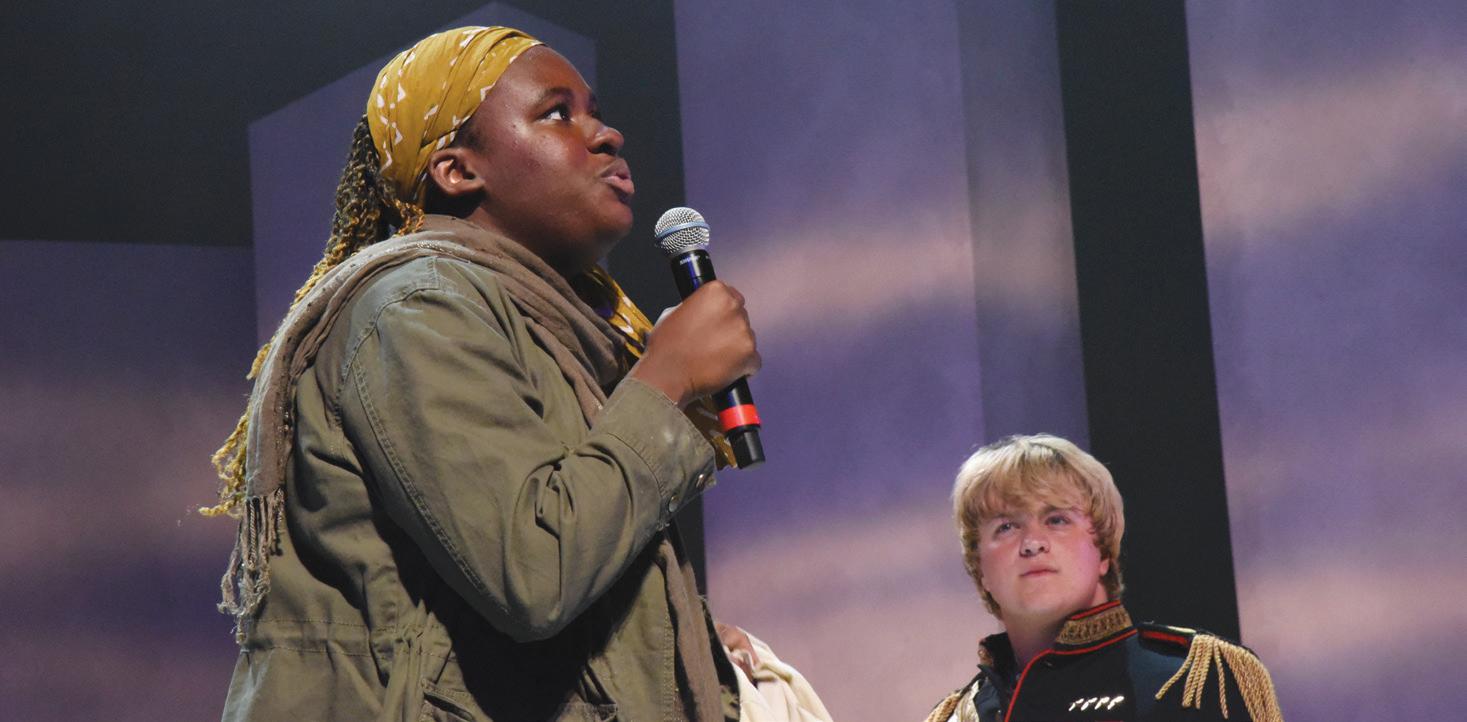
To Quinn, the story of Antigone is important to tell to society. History will always repeat itself and the story will be relevant despite it being written so long ago. Quinn believes that the story reminds us that kings and rulers are still just humans and that they need to work to be able to help other humans.
"This is a really dark story, but similar things have been happening," Quinn said. "I feel like they're young girls who stick up to the government time and time again. There have been stories like Antigone and there will always be Antigonies, and there will always be Creons."
CULTURESan Marcos celebrates culture at 12th annual Sacred Springs Powwow
By Zachary Scott Life and Arts ContributorThe smell of incense and the unmistakable beat of the drum marked the return of the Sacred Springs Powwow since an indefinite in-person postponement, Saturday-Sunday at The Meadows Center.
The Sacred Springs Powwow is organized by the Indigenous Cultures Institute (ICI), a nonprofit that works to preserve the history and culture of Indigenous communities through education and cultural repatriation efforts. The program is funded by the Texas Commission of the Arts, the San Marcos Arts Commission, the Tomblin Family Foundation, Pedernales Electric Coop Charities and Friends of the Powwow.
In 1995, San Marcos experienced its first powwow, led by the late local music legend Lucky Tomblin and his family on the shores of Spring Lake, a sacred site for the Coahuiltecan people. The Sacred Springs Powwow is conducted annually in honor of the Tomblin Family.
Aaron Pyle, a member of the Board of Elders of the ICI, has been part of the Sacred Springs Powwow since it began. Although he was removed from his Choctaw heritage at the age of 13, Pyle was able to reconnect with his roots during his time as a student at Texas State.
"The Native way of life is all about building relationships," Pyle said. "So much of our history is challenging, so the focus on community, culture, and connectivity is how the Indigenous Cultures Institute carries on its legacy."
A powwow is a festival where people from various indigenous cultures gather to celebrate Native American culture with drums, dancers dressed in regalia and Native food.
After a brief two-year in-person hiatus due to COVID-19, the 12th annual Sacred Springs Powwow on the shores of Spring Lake brought over 100 traditional musicians and dancers, educational workshops and vendors.
The San Marcos springs remain one of the oldest continually inhabited sites for the Native Americans of south Texas and northern Mexico, collectively called Coahuiltecans. A string of cave drawings from an estimated 4,000 years ago, called the White Shaman Mural, connects the four major springs of the Edwards
Aquifer to the origin story of the people.
Although the Coahuiltecans are one of the smallest populations in the nation, the ICI plans on continuing its outreach to the San Marcos community.
"We have good stories and good traditions to pull from; we are just trying to find an opportunity to let the community access it," Pyle said.
The weekend's celebration brought over 40 vendors. Smiling faces behind tables lined with homemade jewelry, colorful tapestries and dream catchers served the 5,000 attendees over the two-day event.
Oscar’s Bows, founded by San Marcos native Oscar Duran, was one of the vendors present at this year’s event. Aided by his wife and daughter, Duran sold his hand-carved bows, arrows and knives in his 20th year attending the powwow.
"I am looking forward to educating people with the items that I excel in and meeting new people," Duran said. "Educating at Powwow is important because people get the information from someone that has talked about it for years. You could always read about it but hearing about and seeing it face to face is more interesting."
Duran has been making his bows ever since he was a child. He said that he continues to attend the celebration every year because he has always been fascinated by the culture on display, despite not being Native American himself.
Texas State's Hispanic Business Student Association (HBSA), Bilingual Education Student Organization, Hombres Unidos, Sigma Lambda Beta and Sigma Lambda Gamma co-sponsored the event as well.
Nathan Kohut, a history senior, is a member of Texas State’s Sigma Lambda Beta fraternity. As former president of the chapter, Kohut is no stranger to community service in San Marcos.
"Ultimately, yes we pay tuition to be here as students, but we are hosted by the San Marcos and Texas State community," Kohut said. "At the end of the day, it's important for student organizations to give back."
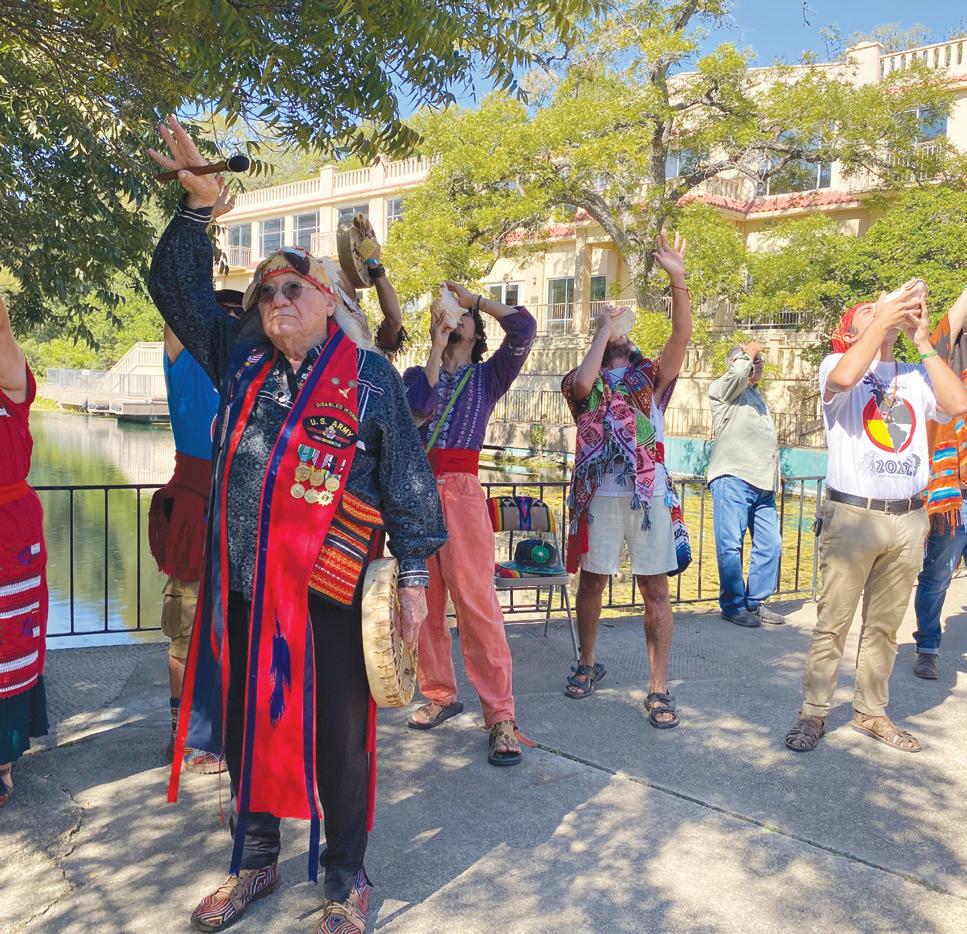
Because service is one of the pillars of Sigma Lambda Beta, Kohut was eager to help out this year. Kohut said he always looks forward to the vendors, food and the Native culture on display at the powwow.
Among other attractions, the main event of each powwow is the dance competition. Under the Arena Tent, dancers come from across the country to
compete for $12,000 in cash prizes.
This year, hundreds of dancers competed in multiple categories for prize money. The women’s competition featured Cloth, Buckskin, Fancy Shawl, Jingle and Golden Age dance categories. The men's competition had Traditional, Straight, Fancy, Grass and Golden Age dance categories. Youths this year also competed in the Girls, Boys and Tiny Tots categories.
Mario Garza board of elder’s chair and the principal founder of the ICI, is a driving force behind the continuation of the tradition of the Sacred Springs Powwow. Since 1995, Garza and the ICI have continued their work through educating the public and repatriation efforts such as the Sacred Springs Powwow as well as summer youth programs and native language workshops.
"The purpose of the powwow is to educate," Garza said. "We do this to let people know that we survived, that we are still here celebrating our culture and that we will be around for a while."
For more information about the Annual Sacred Springs Powwow, visit https://www.sspowwow.com/.
Texas State theatre juniors Sydney Cooper (left) and Kaleb Quinn rehearse in dress rehearsal for the prodcution of Antigone, on Monday, Sep. 26, 2022, at Patti Strickel Harrison Theatre. PHOTO BY BEN MIDDLETON The principal founder of the Indigenous Cultures Institute Mario Garza kicks off day two of the 12th annual Sacred Springs Powwow, Sunday, Oct. 2, 2022, at the Meadows Center. PHOTO BY ZACHARY SCOTTARTS
Campus gallery shares memories of Selena
By Brianna Chavez Life and Arts ReporterSitting in The Wittliff Collections in San Marcos, Texas, snapshots and memorabilia of the beloved singer and performer Selena Quintanilla are on display. Visitors of the gallery can witness the Queen of Tejano Music, a global icon with superstar charisma and grace, in its newest collection, the La Avenida gallery, during Hispanic Heritage Month.
A young woman who lived the American dream until her death in 1995, Selena Quintanilla is remembered through her music, her style and the photos that encapsulate her smile forever in time.
Hector Saldaña, the Texas music curator for The Wittliff, noticed how students and visitors were drawn to photos of Selena on display in previous galleries. Since she is well known for her iconic look and for capturing the hearts of many Americans, especially Mexican Americans, Saldaña said Selena is as much of an icon as Marilyn Monroe or James Dean.
"Selena is one of those artists that is a true icon, but an icon that stayed close to home here in Texas," Saldaña said. "She showed the world that someone that looks like us can make it big."
Al Rendon, Selena's photographer from 1992 until her death in 1995, recounted many memories he had with the Tejano star, sharing captured moments of live concerts, her with family and even promotional photos for Coca-Cola. His photos have been featured in publications like People and Newsweek as well as in the Smithsonian Institution.
Rendon got to share some of his photos with The Wittliff after connecting with Saldaña right before Hispanic Heritage Month began. This inspired Saldaña to get in touch with Rendon and create a Selena display on a large scale. Several other photos of Selena from photographers Ramón Hernández and John Dyer.
Saldaña wanted to know if Rendon had a photo that had yet to be seen in the public eye. Saldaña was in luck.
"I wanted to know if [Rendon] had anything that hadn't been seen," Saldaña said. "This photo has never been seen, never been published and had yet to be on display until today."
Although many photos taken by Rendon are on display for visitors, it is the picture of a young Selena that he found while searching through his photos that is grabbing attention. This is the first time the photo has been published or on display.
The photo is of a time before Selena became a household name when she performed with her family band, Selena y Los Dinos. The photograph shows a young Selena dancing onstage. Rendon believes it was taken in the early 1990s in San Antonio. He remembers being in awe of the young performer.

"I was immediately drawn in awe with how well the band's music sounded and Selena's performance
So far, Brady has interacted with over 500 people within the Texas State community including faculty, staff and students with Marsteller's help.

As a first-generation college graduate and Texas State alumna, Marsteller obtained her master’s degree in criminal justice at the University of Cincinnati in 2015. Marsteller encountered the stressful role of being the first person to assist someone in potential danger as a 911 dispatch supervisor for the Comal County Sherriff’s Office in New Braunfels until 2018.
After her role as a 911 dispatch supervisor became too overwhelming, Marsteller returned to Texas State to serve students and start her journey to become a victim services advocate and later, a mental health officer.
As a victim services advocate, Marsteller felt that she was on the tail end of cases. She believed becoming a mental health officer would allow her to understand cases from the beginning and to follow through with each victim. After training to become a mental health officer, Marsteller knew she made the right choice.
"Being someone who has not had the greatest experience of law enforcement, my whole passion was to change that," Marsteller said. "Being a dispatcher is very stressful because you are the first person to answer the phone in someone’s crisis, but with victim services, you’re there on the scene of maybe a death and you’re having to consult the family. That's what led me to mental health and eventually Brady because I wanted to better what’s best for our community."
So far, Marsteller and Brady have partaken in about 97 visits to classrooms, dorms and Texas State events. They have made appearances at events such as the LBJ Picnic, Freshman Takeover and New Student Orientation to support students and teach them about Brady's job on campus.
The duo has also recently started visiting classrooms, one of the first being a freshman university seminar course. Kimberly Conner, the copy editor for the Division of Technologies Marketing and Communications team at Texas State, teaches the seminar. She was offered to invite Brady and Marsteller to her class after meeting him for the first time at the Under the Arch Meet and Greet for President Kelly Damphousse in July.
Conner loved the experience that Brady and
overall," Rendon said. "You can just tell when someone has it, and I knew she was going to be big."
Rendon began asking Selena's record company, EMI Latin, to let him photograph her next album cover, which he ultimately did not get. However, after the record company rejected the original photographer's shots, Rendon got the call to step up to the plate and shoot the cover of her third studio album "Entre a Mi Mundo."
"I had been waiting for this opportunity," Rendon said. "I felt like we had a great working relationship, and I gave her the freedom to do her thing."
In the three years Rendon got to work with Selena, he gave her total freedom to pose, dress and act in the photoshoots. Unlike the control that the record company and other photographers had on the singer, Rendon captured what Selena wanted. He would get calls from Selena's family wanting his photography after rejecting photos of Selena from other photographers who did not make the cut.
"That made me feel really good because she was obviously not feeling that these other photographers [were] capturing the real her," Rendon said. "She knew when I'd work with her, I would present her more naturally the way she is."
This was evident in the Coca-Cola advertising photos that Rendon took in 1994, photos that are on display in the La Avenida gallery. The photo shoot did not start with her dolled up in her outfits. Rendon said he wanted it to be a slow progression toward flashy fashion. He first wanted to capture the natural and carefree Selena; the Selena that fans loved. Eventually, Rendon photographed the Tejano star in her iconic looks, Coke bottle in hand.
"Her real self came out of the photos I would take of her," Rendon said. "They weren't manipulated to look like someone she wasn't, which I think she appreciated about me as a photographer."
This would be Rendon's last photo session with Selena before her death.
The news of Selena's passing shattered the lives of everyone who knew and admired her. It left family, friends and fans wondering what would have been of the Queen of Tejano Music and the obsession of the icon. From film to makeup, Selena's impact on the world is evident 27 years after her death.
Miguel Guzman, a mariachi educator at Texas State's school of music, remembered how somber it was to be a studio musician for Selena's second posthumously released album "Siempre Selena" over a year after her death. The album contains unreleased work from the singer as well as remixes of previous songs she had released.
He was contacted by his friend and musician Henry Gomez, who had worked with Selena and her family when the singer was still alive, to be a part of the project. Guzman was a part of three tracks on "Siempre Selena."
"It was beautiful but also chilling being in the
Marsteller gave in the classroom, and she recommends freshmen meet him, especially if they need a calming personality to be around.
"Brady turns the whole stress level down," Conner said. "He’s also very approachable, and it’s nice because sometimes with other service animals, they’re so pristine and you’re not sure if you can touch them, but with Brady, you don’t have to behave in a certain way or perform certain commands with him. It’s also amazing that he and Officer Marsteller don’t make you feel rushed or like you’re an inconvenience; it's your own experience that you can have at your own pace."
Also offered to Texas State students through Common Experience is Pawfficer Brady’s Common Reading Book Club. The book club will get together to discuss this year's Common Reading book, "Weapons of Math Destruction: How Big Data Increases Inequality and Threatens Democracy" by Cathy O'Neil on Thursday, Oct. 20. Brady's presence will ease the stress and anxiety that being in a group setting may present for some students.
Natalie Coody, a criminal justice junior and student worker for Carmichael, believes that the personality that Brady has will allow students to destress, especially with the help of one of his favorite treats.
"Brady is just such a sweet dog, and he just loves everybody," Coody said. "You have to be careful when you open the ice machine though, because he will magically appear. He brings a lot of calmness to people, and I think having him around is like a sense of security."
The future for Marsteller and Brady is strong, and Marsteller only hopes it expands into something greater to help students and alter the negative reputation of mental health.
"I would love to see this program grow," Marsteller said. "I know mental health has always had some sort of negative stigma to it and I want to change that. To do that, I want this program to grow so other police departments and universities could look at us and think 'I want to do what they’re doing.'"
To keep up with Brady and Officer Marsteller, visit their Instagram, Twitter or Facebook @PawfficerBrady.
recording studio," Guzman said. "We had a big painting of her in the studio and you could hear her singing but knew that she was dead, yet somehow still with us."
Although she has physically passed on, Selena's presence is still felt and her memories live to tell younger generations the story of the American dream; how a girl from Texas with amazing talent got to achieve her wildest dreams.
Guzman believes that people can resonate with her story, especially young Latinos who, like Selena, do not speak Spanish fluently. Guzman said she was a catalyst in shining a light on the Mexican American experience.

"Even now us Latinos are trying to identify with someone that's our color, that's from our area, that is our people," Guzman said. "We have yet to find someone like Selena."
Saldaña is proud of the Selena display that sits at The Wittliff and sees the display as an inspiration to young people, the popularization of Mexican American culture and the continuum of Tejano music.
"I wanted to form the display as sort of an altar in a less dramatic sense," Saldaña said. "The star power that Selena brings in is an inspiration to all and teaches the importance of Texan music and dance, which I think is very important."
To view the Selena Quintanilla display, visitors can visit the 7th floor of the Albert B. Alkek Library at Texas State. Admission to The Wittliff is free.
Selena Quintanilla performs on stage with her family band, Selena y Los Dinos. PHOTO COURTESY OF AL RENDONMUSIC
Stellar Coffee Co. open mic night brews local talent
By Connor Ek Life and Arts ContributorBy day, Stellar Coffee Co. is a study hotspot serving coffee, food and drinks. Thursday nights at the shop, however, call for a transformation of the cafe for weekly open mic nights, an event that has become an outlet for local creatives to express themselves to an audience.
Stellar has been a local favorite in downtown San Marcos and a hub for studying and relaxing since 2018. In 2020, Sean Ryan, a veteran of the San Marcos music scene, was hired as a private contractor to run, supply equipment and organize Open Mic Night.
Ryan's initial idea, coming from a perspective of a seasoned gig musician, came from a sense of wanting to create a platform for young artists looking to open up a space.
"When I first started this open mic, we thought about, you know, maybe limiting it to certain types of acts, or maybe just have musicians and maybe just comics, and we said, 'you know, maybe let's leave it open to everyone and see what happens,'" Ryan said.
Ryan announces and introduces each act as well as supplies sound equipment and instruments for those who need them. The only thing participants need to bring is their talent, ideas and appreciation for other participants.
Ryan leaves things open to participants by letting them express themselves. He focuses on having an environment where there is no judgment, creating an audience dynamic that appreciates and respects every performer.
Those who have a hard time putting themselves out there can breathe easy knowing they do not have to impress an owner of a bar or venue just to perform a song or two. The signup process is as simple as writing their name, act and contact information on a clipboard.
"I just love when someone can really tap into the moment," Ryan said. “Like every single act, I try to remember that and just look for something, you know, inspiring, and nine times out of 10 it happens. Every single act and like man, that was awesome. Like I try to find something good out of it, you know?"
Performance is a big aspect of the night that comes entirely from those who choose to perform instead of having an obligation to play or perform contractually.
Jack Perrin, a performer, frequents the open mic nights and has become a spectacle for those who attend. Performing his self-written piano ballads, he hooks the audience with his gripping vocal ability and moving instrument work.
Perrin, a musical theater alumnus and vocal coach for the Musical Theatre program, has been writing and releasing his music on streaming platforms since 2021. His writing is displayed under the stage name Jack Mogi to create an artistic guise under what he or others create and perform. Perrin paints a picture of experiences and stories through his music about life, whether they are true or surrealist.
"I'm a storyteller. I use my singing as a way to convey a story or tell a story or an emotion, right, particularly an emotion," Perrin said. "I'm not looking
to be just a great singer, which would be fun too, but my favorite thing to write about is just like, in general, someone's story. [Open Mic Night] is a place to practice and a place to practice how to share and to share how to practice."
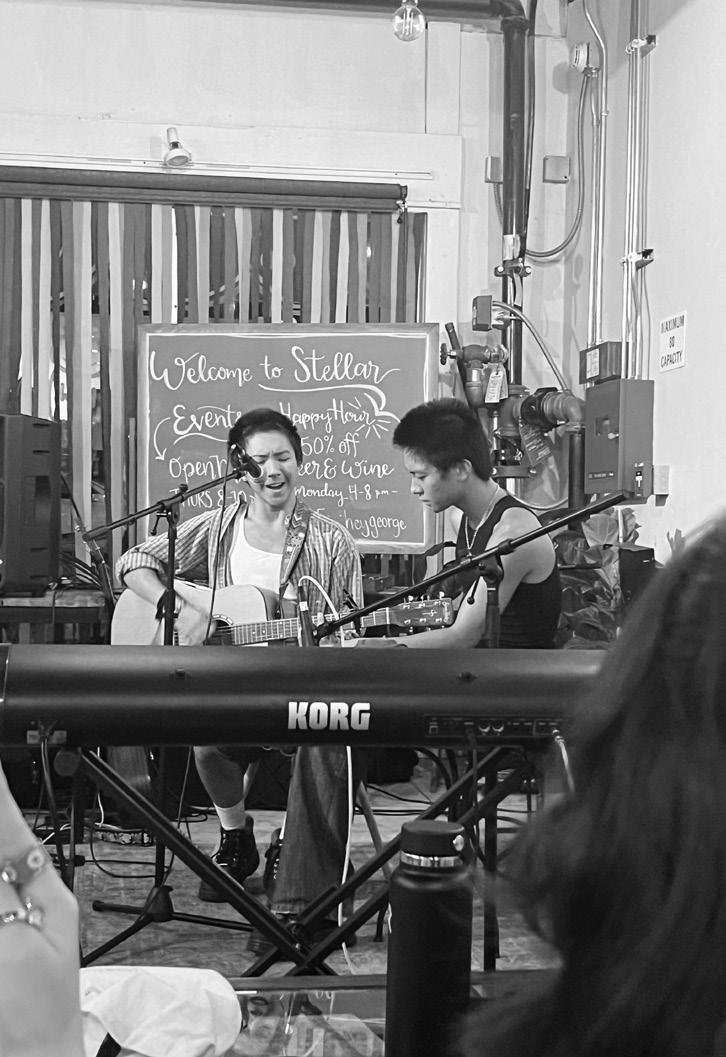
Zen Fernandez, an exploratory freshman, has been a musician his entire life. Writing from his thoughts and experiences, Fernandez feels like the environment in San Marcos boosts his creativity and gives him an outlet to express that.
"I'm actually in a dorm hall with a ton of musicians and they always encouraged me to do the thing that I want to do, which is music," Fernandez said. "And I don't know, I guess being in a different space than like, at home with my parents actually helps a lot. Just feeling independent just inspires me a lot."
Fernandez thrives in smaller, intimate environments, playing with friends and fellow musicians, but is not always used to how a bigger show might play out. With the availability and open opportunity Ryan and Stellar offer, he feels as if he benefits from it.
"I really enjoy Stellar Coffee because it shows the musicians and just everyone that does art here in San Marcos live, and I appreciate that a lot, and I'm glad that I'm part of that," Fernandez said. "I definitely use it as a way to practice just performing in front of people. I'm not used to that as much so I'm kind of thankful for something like that to be here."
Stellar's Open Mic Night has increasingly become a bigger event each week, and the attention is deeply
appreciated by Ryan, and the owner of Stellar, Hope Tate. Tate and Ryan work together to find time to host and promote the event. With Tate wanting to provide a platform for new artists to showcase their talents in a safe space, both Tate and Ryan are aiming and succeeding at making that vision a reality.
To keep up with Stellar Coffee Co.'s open mic nights and its other events, visit @stellarcoffeecotx on Instagram.
'Cats Walk: Daisy Solomon talks mariachi, family
By Monica Vargas Life and Arts Contributor'Cats Walk is a segment that will highlights Texas State students. Web Editor Monica Vargas will talk to a different Bobcat about school, self-love and Texas State.
For this segment, Monica interviewed Daisy Solomon, an education junior with a minor in Latin music studies. Daisy sings and plays violin for Mariachi Nueva Generación. She also played violin in the Texas State Symphony Orchestra during her freshman and sophomore years.
Daisy Solomon's favorite quote: "Hechale ganas mija."
Vargas: How long have you been singing, and how long have you been in mariachi music?
Daisy Solomon: Six years now. I've been passionately consistent with it even though I was very shy in my youth, I've always enjoyed playing music.
I witnessed my mother, a single parent going to a university when I was a toddler. She would always take me with her to her courses, and I got inspired to pursue my education when I got of the age. My music interests and talents started to grow, and my mom along with my extended family supported it. I've experienced many people in music that struggle with families [not] supporting this kind of career in the music industry. It doesn't always get the respect it deserves to be a professional musician, especially in mariachi.
I personally love that Texas State offers a program of excellence that advocates for Latin music and Latin musicians. When I found out Texas State offers this program, I knew this is where I wanted to keep pursuing my career, especially being a female in mariachi which is progressing.

Vargas: Tell me more about Texas State advocating for Latin music.
Daily Solomon: In the 1990s, Professor Lopez started to help support, teach and advocate for a studentrun organization here at Texas State for Latin music studies, in particular, mariachi music. [It was] one of the few universities to offer this program, built from the ground up. Latin Music Studies was established officially here at Texas State in 1997.
As performing started to get extremely competitive, we started to compete in large and very prestigious competitions such as The Mariachi Vargas Extravaganza. The program even brought guest speakers from the Latin music industry and with much support for us as professionals and musicians growing in mariachi and Latin music.
I personally have witnessed the program double in size within one year. I am happy to be a part of this Latin music movement.
Vargas: How was your experience starting as a musician at a large university?
Daisy Solomon: Well, before I came here, I left my home of Edinburg, Texas, in high faith in pursuing my dream, and left all my family, friends and comfort zone to go to the unknown.
When I moved to the dorms, COVID-19 had us all isolated, and courses continued online. I was new to the school, program and everything. I was so thankful for technology and for being able to still connect with my fellow colleagues and musicians.
I started to gain new friendships, mentors, and a new family with the mariachi and salsa ensembles. We would meet and practice on Zoom, and when we were finally allowed to meet again, our performances were perfect pieces that fit together. All of us had been preparing on our own time and via Zoom.
[I am] so thankful for the power of technology. It helped us so much as a whole and community.
Vargas: Tell me the process of getting ready to perform and about your beautiful tailored uniforms, Traje de Charros.
Daisy Solomon: So, I definitely mentally prepare the night before. As a performer, you have to; it's a must. Then the day of the performance it takes about two
hours to do my hair, make-up and my Traje de Charro and then I am ready to go live and perform.
Our Traje de Charros must be respected and taken care of properly, we dry clean them. It is an interesting story about how the Traje de Charros uniform started. In history, musicians in Mexico started to perform in the local areas to make a living. Well, they started to get popular as mariachi musicians and were found by a leader of the community. The leader wanted them to perform for a special event; he wanted them to look their best and purchased these uniforms for them. Since then, that is the story of why mariachi performers wear this attire.
Vargas: Tell me three things you love about yourself.
Daisy Solomon: My persistence when it comes down to reaching for new goals. When something is on my mind, I always want to see it fulfilled. I know lots of paths and crossroads will arise, but I am determined to get to my destination goal. I am a risk taker. For example, when I left home and stepped into the unknown.
I have learned much about my hard work ethic, school and financial independence from my mom, which I appreciate about myself. I'm disciplined and have great time-management skills. It can be rough as there are nights I hardly get much sleep at all. For the most part, I am good with balance, school, my social life and work-life being persistent.
My ability to communicate. I enjoy talking and getting to know everyone. I do not like to judge. I am always willing to let people share their experiences with me with no judgment. I'm willing to learn from others. I am very accepting of meeting people from all walks of life and hearing their life stories.
Vargas: Any advice, you want to give to female singers, mariachi performers and in general?
Daisy Solomon: Don't give up, as cliche as it is. You are going to go through many unexpected situations, especially if you are in an independent manner. You are going to face many hardships. You may feel alone, you must realize people admire you from afar, your family and friends close and far away. There are people out there that care about you and people rooting for you always. Everything has its time. Music brings so much happiness to others, that is what makes us musicians look forward to every performance. Don’t give up.
Daisy Solomon's Instagram: @wydxdaisy
To keep up with students featured in 'Cats Walk, visit The University Star's Instagram @universitystar.
Texas State education junior Daisy Solomon wears her Traje de Charro for the Mariachi Nuevo Generacion Performance, Sunday, Sept. 25, 2022, at The Wittliff Collections inside Alkek Library. PHOTO BY MONICA VARGAS Texas State freshman Zen Fernandez (left) performs at open mic night with sight reading assistance from their brother Zain Fernandez, Thursday, Sept. 22nd, 2022, at Stellar Coffee Co. PHOTO BY CONNOR EK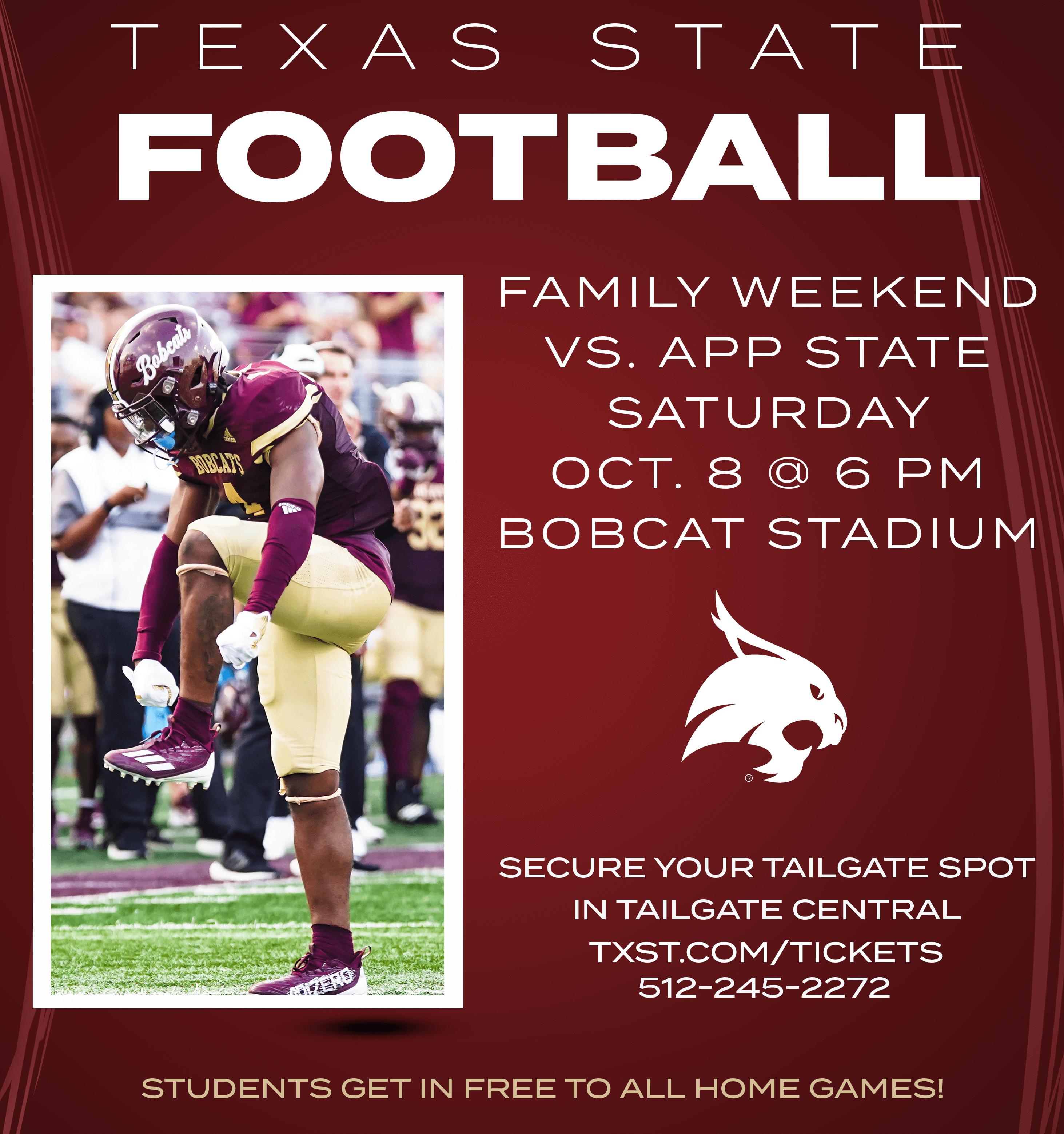




Texas State football should capitalize off transfer rule
By David Cuevas Opinions ContributorIt is no secret that the Texas State football program has struggled since moving from NCAA Division I Football Championship Subdivision (FCS) to Division I Football Bowl Subdivison (FBS) in 2012.
During its decade-long tenure in the FBS, Texas State has compiled an overall record of 38–87, parted ways with two head coaches due to lack of on-field success and has never received a postseason bowl game bid. Texas State's lone winning season as an FBS team came in 2014 under head coach Dennis Franchione.
Texas State's attempt to build a winning football program for the past decade has not worked. Something needs to change if it has any desire to win games consistently and contend for a conference championship. That something could be the NCAA's onetime transfer rule.
After being ratified, the "one-time transfer rule" officially took effect on April 28, 2021, and allows studentathletes the option to transfer to a different school and play immediately one time during their collegiate career. Student-athletes often seek transfers because of issues such as playing time, coaching changes and homesickness. Previously, the rule stated that athletes were required to get permission from their head coach and school athletic department, and if allowed, they would have to sit out the following season.
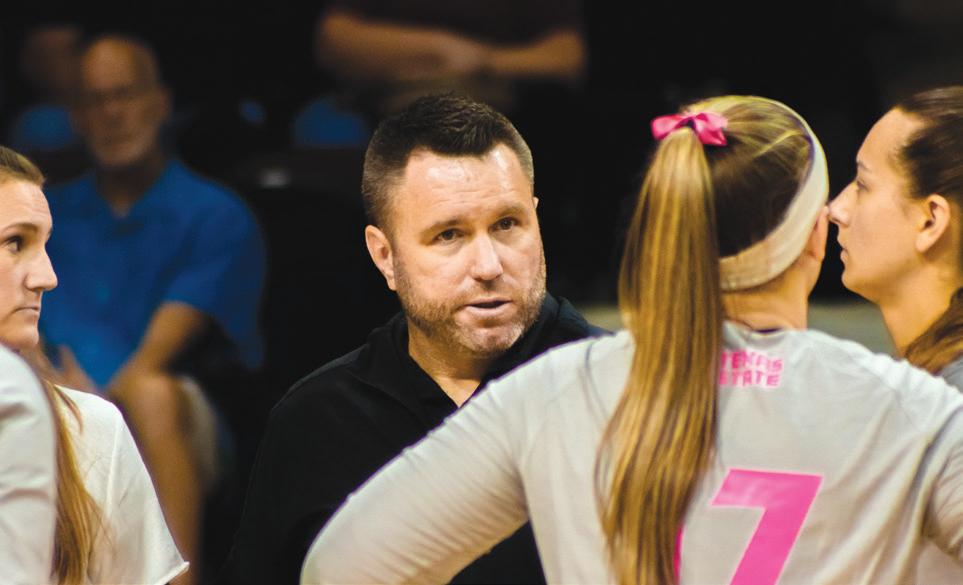
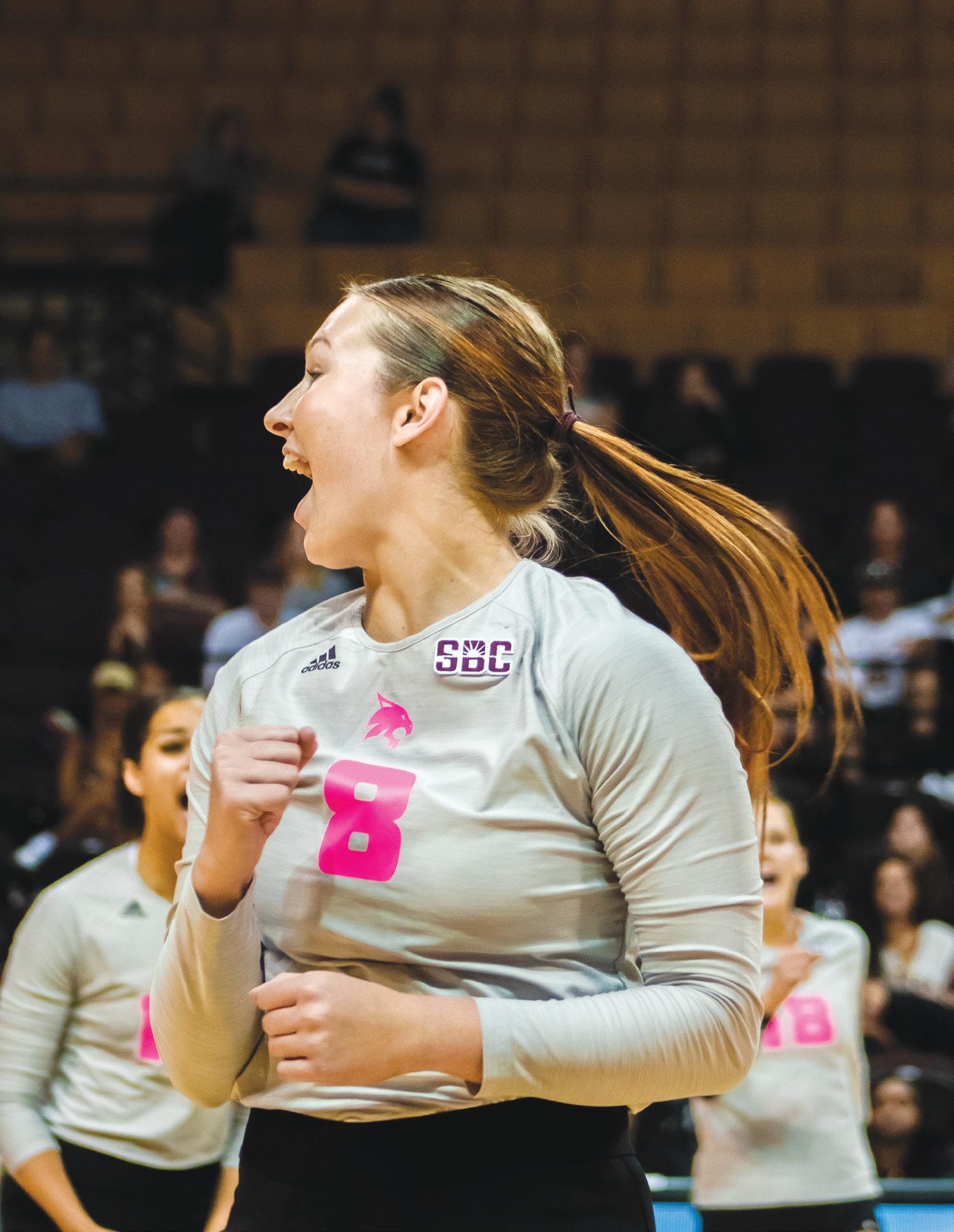
Despite having been met with criticism from national championshipwinning Clemson head coach Dabo Swinney, the one-time transfer rule was quickly embraced by athletes. According to Heartland College Sports, more than 2,000 college football players elected to enter the transfer portal before the season. Redshirt senior defensive end Nelson Mbanasor is one of them.
Mbanasor joined Texas State before the season after spending the last five years at Texas Tech. He has been a tremendous addition to the Bobcat's defensive line, registering six tackles, one sack and one forced fumble through their first four games.
"I put my name into the portal to find the situation that will help me best to get to the next level," Mbanasor said.
Since the rule was set in place,
numerous Power Five teams have taken full advantage of it, turning to the portal to tweak slightly or significantly upgrade their rosters. Texas State is no exception, as head coach Jake Spavital and his coaching staff have utilized the portal heavily. As a result, out of the 85 players on Texas State's current roster, 69 are transfers, 18 of which transferred from the Power Five.

According to 247sports, Texas State only signed a total of three high school recruits last cycle. The team already has a large number of underclassmen primarily because of Spavital's new approach to recruitment in which he constructs the team's roster through the transfer portal.
By doing so, he has increased the team's talent substantially from a season ago. Texas State has been able to attract talented players such as redshirt senior wide receiver and punt returner Rontavius Groves, a transfer from the University of North Carolina at Chapel Hill.
According to Groves, he chose to transfer to Texas State due to the opportunity it presented him on the field, as he felt the spread offense fit his skillset. With the change of scenery, Groves thinks it makes the team much more competitive.
"I think it makes the team better because we all come here with the mindset of, we got to do exactly what needs to be done," Groves said. "We come here behind the curve so you got to try your best to impress and show what you're capable of. Having a team full of those types of guys is more attention to detail it's more of want to its more guys who really depend on this sport, so I think having a team full of transfers is beneficial."
The transfer portal has forever changed college football. If utilized correctly, it could become invaluable to Texas State moving forward as it allows them the opportunity to potentially add talented players that they usually would have little to no chance of being able to recruit out of high school. Even just two or three of these kinds of players would greatly enhance Texas State's roster and very well could be the difference between a losing season and a bowleligible season.
Not only does the transfer portal improve the team's level of talent, but the level of cohesiveness as well.
VOLLEYBALL GALLERY
 ILLUSTRATION BY ALEXANDRA M GARDEN
ILLUSTRATION BY ALEXANDRA M GARDEN
"Us having a lot of older guys out of the portal gives us an advantage because it's a lot more experience," Mbanasor said. "I feel like we play well especially as a defense a lot of guys are fifth even sixth-year guys, so I feel like that's helped us a lot over the course of the season."
Not everyone is optimistic about the transfer portal. As Alabama head coach Nick Saban said, it is "unsustainable." Those who believe it is only beneficial to the top-tier FBS teams as it allows them to freely poach the best players from the Group of Five's by offering them a more lucrative opportunity. As a result, they significantly improve their chances of making it to the NFL.
While all of this is true and will happen, the transfer portal can still benefit Group of Five's.

Only four weeks into the college football season, there has been one of the most memorable Septembers in recent memory, all thanks to the transfer portal. Appalachian State upset sixth-ranked Texas A&M at Kyle Field, Marshall defeated eighth-ranked Notre Dame in South Bend and Georgia Southern beat Nebraska in Lincoln, Nebraska. These are the first and surely not the last Group of Five upsets over notable Power Five's now that the onetime transfer rule exists.
All three teams, as mentioned earlier, are members of the Sun Belt Conference with Texas State. Altogether, those
teams have 89 transfer players on their rosters, showcasing precisely how they all decided to dip into the portal to improve their rosters this past offseason and, as a result, earned them significant victories.
If these teams can accomplish such a monumentally impressive feat by merely convincing a handful of players from the transfer portal to come and play for their teams, there is no reason Texas State cannot emulate it. But it must begin with the transfer portal.
"I think having a lot of transfers will show that this program is about business, that we can win here and will also attract the younger talent coming out of high school," Groves said.
Texas State has gotten off to a decent start in this new era of the transfer portal, laying a solid recruiting foundation. Building on that by striving to bring in the most talented transfer recruits possible to reach lofty new heights.
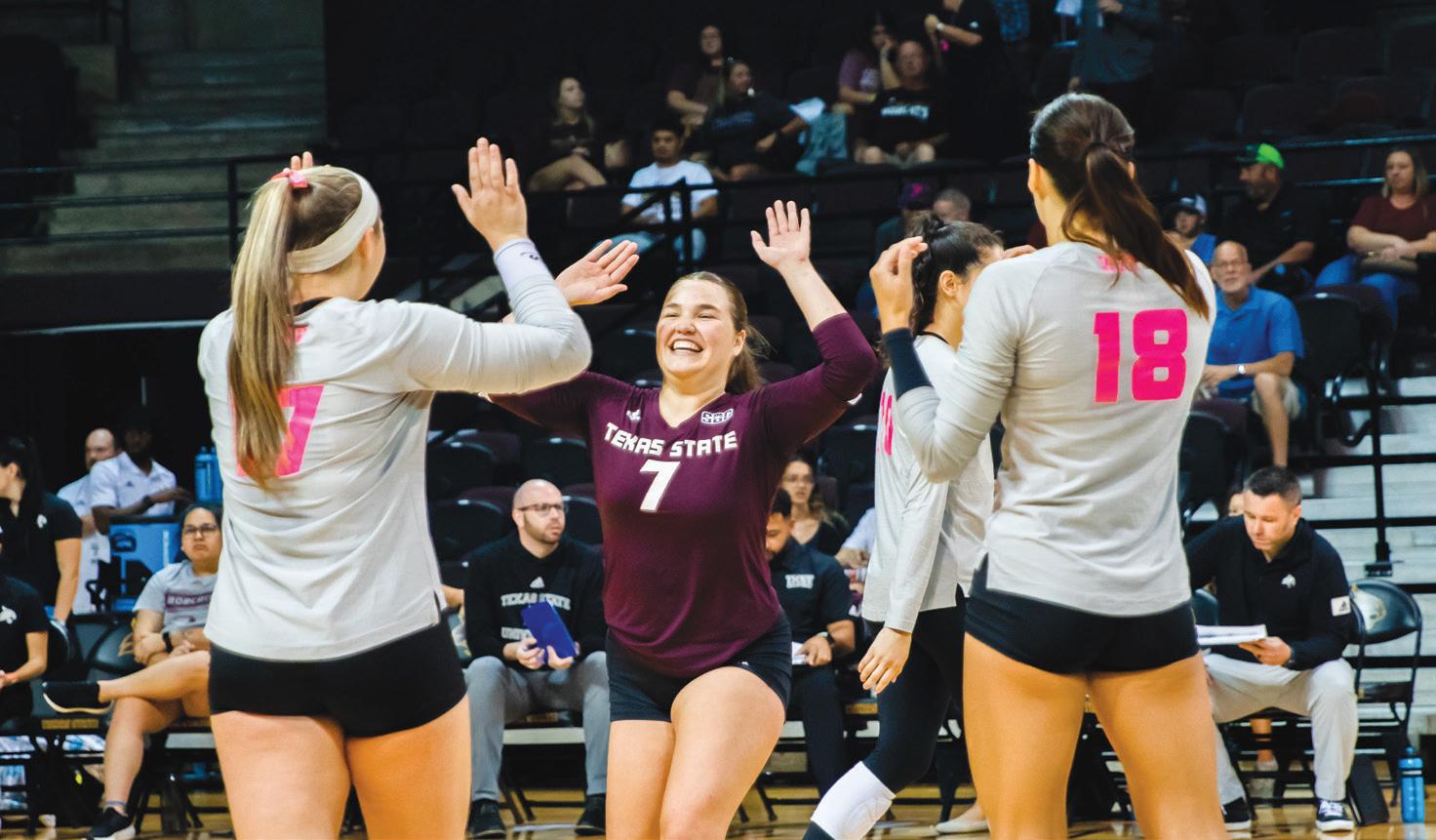
For Texas State, the transfer portal could be the golden ticket to becoming the type of FBS program it strives to be.
- David Cuevas is a journalism juniorThe University Star welcomes Letters to the Editor from its readers. All submissions are reviewed and considered by the Editor-in-Chief and Opinions Editor for publication. Not all letters are guaranteed for publication.
Dillon Opinions in The University Star are not necessarily those of our entire publication, Texas State University’s administration, Board of Regents, School of Journalism and Mass Communication or Student Publications Board. Texas State sophomore defensive specialist Jacqueline Lee (7) celebrates with teammates during a match against James Madison University, Saturday, Oct. 1, 2022, at Strahan Arena. The Bobcats tied the weekend series 1-1. PHOTO BY VANESSA BUENTELLO Texas State senior middle blocker Jillian Slaughter (8) celebrates after the Bobcats score during a match against James Madison University, Saturday, Oct. 1, 2022, at Strahan Arena. The Bobcats tied the weekend series 1-1. PHOTO BY VANESSA BUENTELLO Senior outside hitter Lauren Teske (18) serves the ball in a game against James Madison University on Friday, Sept. 30, 2022. The Bobcats lost the match in five sets. PHOTO BY CARSON WEAVER Texas State volleyball head coach Sean Huiet talks strategy with his team during a time out in a match against James Madison University, Saturday, Oct. 1, 2022, at Strahan Arena. The Bobcats tied the weekend series 1-1. PHOTO BY VANESSA BUENTELLO PHOTO BY VANESSA BUENTELLO See more photo galleries with the QR code below:Volleyball:
Volleyball split its season series against James Madison University last week with a five-set loss on Friday night and fourset victory on Saturday afternoon.
On Friday, the Bobcats led James Madison in kills 75-67, but 13 total blocks across five sets overpowered the Bobcat offense. Senior outside hitter Caitlan Buettner led the team on Friday with 19 kills.
On Saturday, the Bobcats matched James Madison in blocks with nine apiece. The Bobcats won the win clinching fourth set in a dominant 25-12 showing, with senior Lauren Teske amassing 18 of the 66 total kills throughout four sets.
Volleyball will face the University of Louisiana at 6 p.m. Friday, Oct. 7 and at 2 p.m. Saturday, Oct. 8.
Soccer:
Texas State soccer gained its' third win in Sun Belt Conference play with a 1-0 victory against the Southern Miss Golden Eagles last Saturday on Oct. 1.
The Bobcats led the Golden Eagles in shots 14-6, and the lone goal scored was headed into the net by a Southern Miss defender.
Sophomore goalkeeper Katelyn Chrisman recorded her third shutout of the year with the win, tallying three saves in the effort.
The Bobcats will face James Madison University at 6 p.m. on Thursday, Oct. 6 at the Bobcat Soccer Complex and the University of Louisiana at 1 p.m. on Sunday Oct. 9 at Home Bank Soccer Facility in Lafayette, Louisiana.
Football:
Texas State football lost its first Sun Belt Conference matchup 40-13 against the James Madison Dukes last Saturday.
Texas State was held to 246 yards by the Dukes, with 201 of those yards coming in the second half.
The game was affected by Hurricane Ian, something head coach Jake Spavital said influenced the Bobcats' play.
"We knew there would be some adversity just based off the elements, and we told the kids to keep fighting," Spavital said.
The Bobcats will face Appalachian State at 6 p.m. next Saturday Oct. 8 at Bobcat Stadium in San Marcos.
Women's Golf:
Texas State women’s golf team finished 15th in a field of 16 teams at the Schooner Fall Classic in Norman, Oklahoma last week.
Texas State registered a 13-over par team score in the final round to conclude the tournament 25-over. The team finished 10 strokes behind Illinois and 13 behind UTSA.
Juniors Junia Gabasa (69-75-72) and Marine Griffaut (69-71-76) recorded three birdies in the final round of the tournament, the highest score of the day among the Bobcats.
The Bobcats will return to San Marcos to host the Jim West Challenge at the Kissing Tree Golf Club from Oct. 23-24.
Cross Country:
Texas State cross country competed in the Chile Pepper XC Festival in Fayetteville, Arkansas last Friday.
Sophomore Megan Ombres set a personal best while competing in the Women Prairie Fire Pepper 5K with a time of 18:25.5, placing fourth overall in the event.
Ombres finished ahead of junior Daniela Wisniewski, who placed ninth in the 5K event with a time of 18:43.0.
Sophomore Dylan Pitts finished 43rd overall in the Men Prairie Fire Pepper 8K with a time of 26:42.2.
The women's team placed seventh in a field of 34 schools, and the men's team placed 12th among 38 teams.
CLUB SPORTS
Wakeboarding club builds culture around water sports
 By Vanessa Buentello Sports Contributor
By Vanessa Buentello Sports Contributor
Down at the Texas Ski Ranch in New Braunfels, Texas, wakeboarders line up on the dock, anxiously anticipating their turn on the cable. From experts to novices, the Texas State wakeboarding club has built a culture centered around community, friendship and the love for the water sport.
Texas State Wake was founded in 2012 and has since expanded from being a small club to a competitive team. The team, which recently competed in the Eagle Claw Classic with three members placing on the podium, is constantly traveling around the state to compete with other collegiate wakeboarding teams in Texas.
Texas State Wake President August Ashlock, a construction science and management senior, joined the team a year and a half ago not knowing how to wakeboard.
“It took me seven tries to get off the dock," Ashlock said. "I got to the first corner, took about three days to get around the whole thing. And then it took me about two weeks to hit a jump, and then about a month to do my first flip...now, I’m president.”
After banter with his new roommate about their wakeboard mounted on the wall as a decoration, Ashlock asked him about the idea of actually using and trying it out. Shortly after, Ashlock bought his own wakeboard and decided to join the Texas State team.
Texas State Wake welcomes anyone of all levels of experience to join. The club offers a boat team, a wake team as well as the choice of being a general member to hang out with the team at community events or watch competitions.
While some members signed up with the drive to try a new sport, others like Wakeman Fussell, a marketing sophomore and the club's vice president, came into college with the interest of joining the team.
“My family grew up wakeboarding,” Fussell said. “I’ve always been on a boat my whole life.”
As someone who has been on a wakeboard since the age of 10, Fussell’s father introduced his family to the sport after working for a boat company and growing up doing water sports himself. Fussell’s sister has even joined the family tradition and now wakeboards on the Texas A&M wakeboarding team.
“I’ve never been good at many of the typical [sports], like football, baseball or basketball. [Wakeboarding] is just
something that my family has always been super passionate about,” Fussell said. “It just makes me want to be super passionate about it too. It’s a good time for everybody to come together.”
The team has become a family itself. Members find ways to spend time together on and off the board almost daily, ranging from community activities like bowling, nights at Sewell Park and texting each other in their group chat.
“If [the team] is ever doing anything, they’ll say ‘hey, I’m at the library,’ or ‘we’re doing volleyball tonight,’ ‘hey we’re doing bowling,’” Riley Robinson, a communication design sophomore, said. “They text in the chat and we just go.”
Robinson joined the wakeboarding team less than a month ago after the team was doing community outreach on The Quad to recruit new members. She came with a bit of experience from when she was younger but had not thought of getting back into the sport until she approached the tent. Since then, Robinson said the team has been nothing but welcoming and supportive of her wanting to improve in the sport.
“They’re super inclusive, even though every time I get up, I fall. They all want me to do my best and succeed,” Robinson said. “[The team] is very helpful and they give great advice.”
The love for being on the water seems to be a driving factor for the team. Kaito Letkiewicz, an ocean surfer and business management junior, picked up a wakeboard for the first time three weeks ago wanting to try another water sport.
Trying to correlate his experience surfing to wakeboarding, Letkiewicz still considers himself a beginner. His goal, however, is set on competing. Since starting, he has already been making progress and has learned new tricks.
“It’s very doable,” Letkiewicz said. “I just like trying new things and meeting new people and that’s kind of the whole point of the club.”
Fussell said that the common interest shared by the wakeboarders builds a stronger bond and connection with the team. Because the club accepts members from all experience levels, Fussell said that he felt part of a community during his first year on the team.
"It's a really good place to make friends and have a good time if you're in college," Fussell said.
For more information on Texas State Wake, visit its Instagram @texasstatewake.
FROM FRONT ATHLETICS
One of the biggest questions Texas State faces heading into the upcoming season is how the team will replace the production of closer Tristian Stivors. Stivors, one of the greatest players in program history, was a consensus AllAmerican who led the nation in saves and was a massive piece to Texas State’s success in 2022.
His successful 2022 campaign led to him being selected by the Chicago White Sox in the 16th round of the MLB draft this past summer. With Stivors now pitching in the minor leagues with his new organization, Trout knows replacing his productivity from last season will not be an easy feat.
However, Trout has faith in the talent he has in the back end of the bullpen.
“A guy like him, I don’t know if you replace him with one guy ... there's a lot of good talented arms back there that can make that happen," Trout said. "Some are just new and we haven’t seen and some probably haven’t been in that spot ... that’s what the fall is for; to try and figure out how do you start building your staff ... especially when you lose key guys like Stivors.”
As for the players themselves, they are taking a next-manup mentality to replace the production from key graduates. Senior outfielder Jose Gonzalez, who was named to the 2022 All-Sun Belt Conference Second Team, said it will be hard to match the numbers from the former Bobcats, but he trusts that he and his teammates can put the pieces together.
“We’re going to have to have some young guys step up and I think they will and be ready for the challenge,” Gonzalez said.
Although Stivors and reigning Sun Belt Player of the Year and Minnesota Twins draftee Dalton Shuffield are no longer a part of the squad, expectations surrounding the program are still high. There are 23 players returning from last year's record-breaking team, and the Bobcats will set out to prove that the 2022 season was not a fluke, rather the new standard for Bobcat baseball.
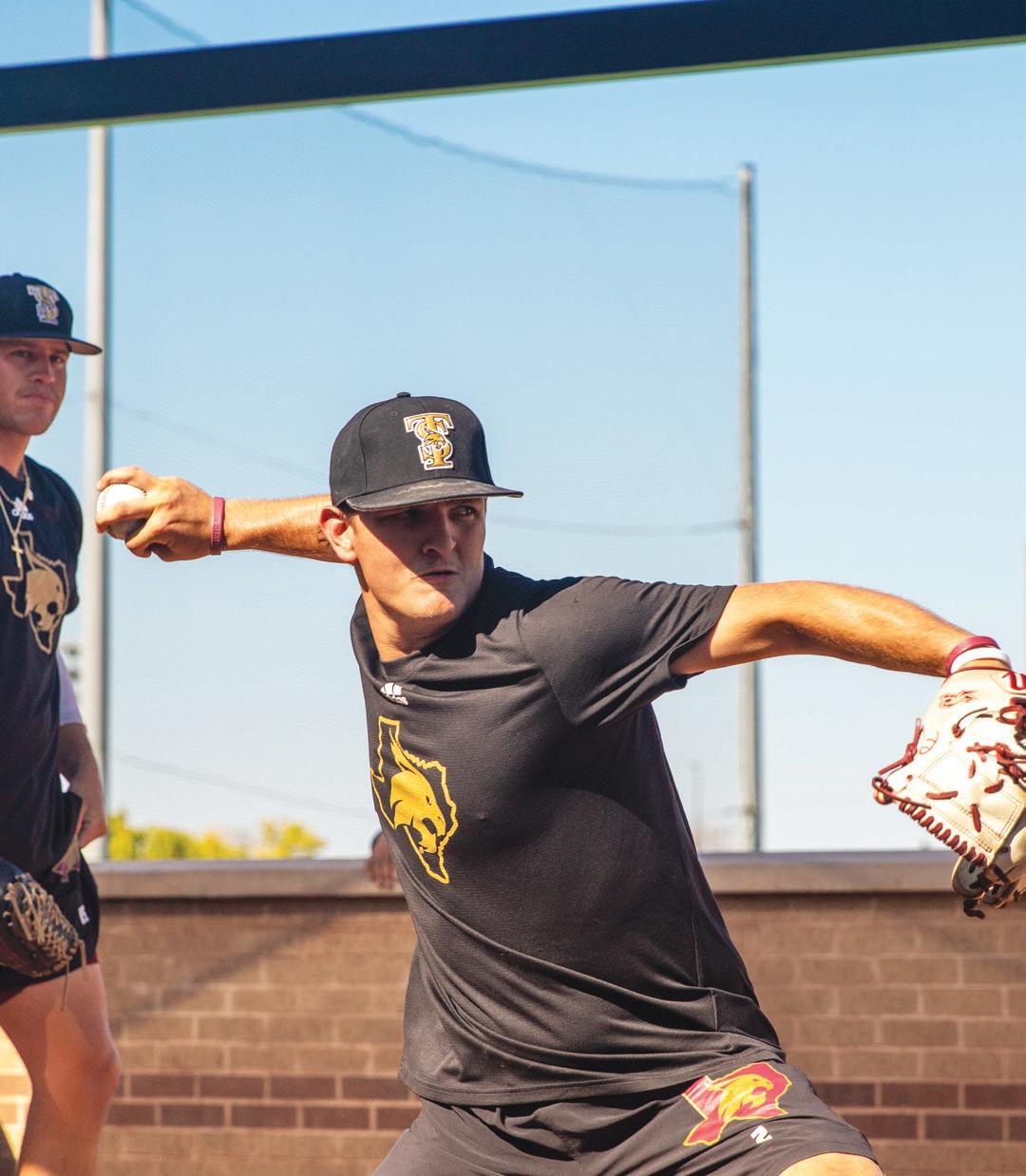
“I think last year definitely gave us a taste of what this team and program is capable of and this year’s team, we don’t have a different goal in mind," Gonzalez said. "We want to get right back to the same place and hopefully go further than we did last year.”
Last year's run gave the program playoff experience, and the team knows what it takes to further advance into the postseason. After coming within three outs of punching a ticket to Omaha for the first time in program history, the goal for the 2023 team is simple: make it back to regionals and finish what they could not a season ago.
“From a pitching aspect I really think we’re going to throw the ball super well this year ... everybody got a year older and a little bit stronger, a little more athletic," Robie said. "I think offensively we have some really big pieces coming back ... that philosophy of the offense is definitely still there."
Texas State senior pitcher Triston Dixon (2) throws the ball during fall baseball practice, Thursday, Sept. 29, 2022, at Bobcat Ballpark. PHOTO BY VANESSA BUENTELLO Carson Weaver Texas State alumnus Eric Reynolds wakeboards on the Texas State Wake Alumni, Thursday, Sept. 29, 2022, at Texas Ski Ranch. PHOTO BY VANESSA BUENTELLO